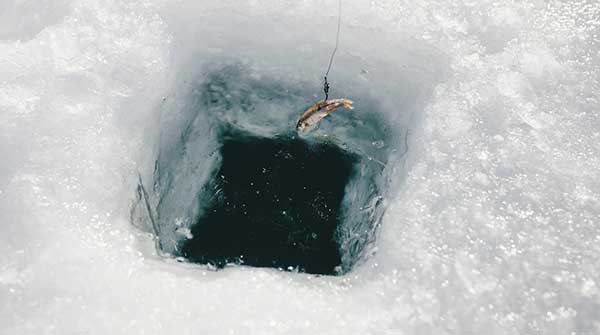Fish use various techniques to survive. But they are a creative bunch – they have to be!
 What do fish do when the water freezes? This is certainly an issue for fish that live in our part of the world. We know that some remain active, or how else could our winter ice-fishing industry survive? But do all fish just swim around under the ice waiting for winter to end?
What do fish do when the water freezes? This is certainly an issue for fish that live in our part of the world. We know that some remain active, or how else could our winter ice-fishing industry survive? But do all fish just swim around under the ice waiting for winter to end?
The simple answer is ‘no,’ so let’s explore this a bit. First of all, we have to understand something about lakes and rivers in winter.
In smaller rivers, we can see how the flow of water around obstacles can keep part of the water open year-round, and therefore it remains oxygenated and is easier for fish to survive. However, lakes and larger rivers don’t generally have this attribute as they are completely ice-covered for months, so other factors must be at play. Lakes gradually freeze from the top down, usually with a layer of unfrozen water below the ice pack. This is the layer the fishermen penetrate to catch those species that continue to swim freely all winter.
 Photo by Joe Eitzen |
| Related Stories |
| An epic fishing adventure at the Arctic Circle
|
| Padre Island: peace, tranquility and fabulous fishing
|
| How to read animal tracks in the snow
|
Oxygen is critical to all life living in frozen ecosystems, so if the oxygen is completely depleted, everything will die. Oxygen levels change throughout the season and throughout the lake. Since the bottom of a lake is the least oxygenated during winter, it would generally be fatal for fish to stay in the deepest parts of the lake throughout winter. Instead, it’s better to stay at middle depths as these tend not to freeze while still having sufficient oxygen available for the fish.
Fish use various techniques to survive. Some will flee the area before it freezes, but this requires a suitable nearby habitat with food and sufficient oxygen all winter. Others can move to areas of the lake or river that will remain highly oxygenated all year, such as inflows and outflows.
Where the option to leave is unavailable, different fish species will respond differently. Northern Pike will remain quite active all winter while bass will slow their metabolism, circulatory processes and even respiration to the point where they are essentially immobile and just barely alive. This is called estivation.
Many benthic (bottom-dwelling species) move to the shallower areas of the lake as these areas remain oxygenated throughout the entire water column so that they can find air at any depth. Some species, such as Mud Minnows, seek out air bubbles under the ice and use these as their oxygen source. Others, such as the Gobi, will burrow into the mud at the bottom of the lake and enter estivation until conditions improve. Still others get oxygen by absorbing it through the skin or into the blood vessels in the walls of their bladders, stomach and gut.
However, even with open water and ample oxygen comes risk as organisms and processes gradually deplete the available oxygen. Plants that produce oxygen all summer now consume it in winter, further reducing available free oxygen needed by other living organisms.
Fish are cold-blooded, but one of the perils of staying active in winter is that the fish have to offset the potential for hypothermia. On the coldest days, the colder water just below the surface can drop below one-degree Celsius, a critical temperature for fish to survive.
I’ve already mentioned that bass slow their processes to combat this, but other species, such as perch, do exactly the opposite. They increase their activity, which uses more energy and oxygen. Some species, such as pike, increase the oxygen levels of the adjacent waters where they winter. They remain active just below the underside of the ice and use their fins and gill plates to slowly move the water near them. Oxygen, frozen in the ice, is gradually released as the warmer currents, created by the fish, slowly melt the undersurface of the ice so the fish can breathe.
Fish are a creative bunch – they have to be!
Geoff Carpentier is a published author, expedition guide and environmental consultant. Visit Geoff on LinkedIn, Instagram and Facebook.
For interview requests, click here.
The opinions expressed by our columnists and contributors are theirs alone and do not inherently or expressly reflect the views of our publication.
© Troy Media
Troy Media is an editorial content provider to media outlets and its own hosted community news outlets across Canada.

